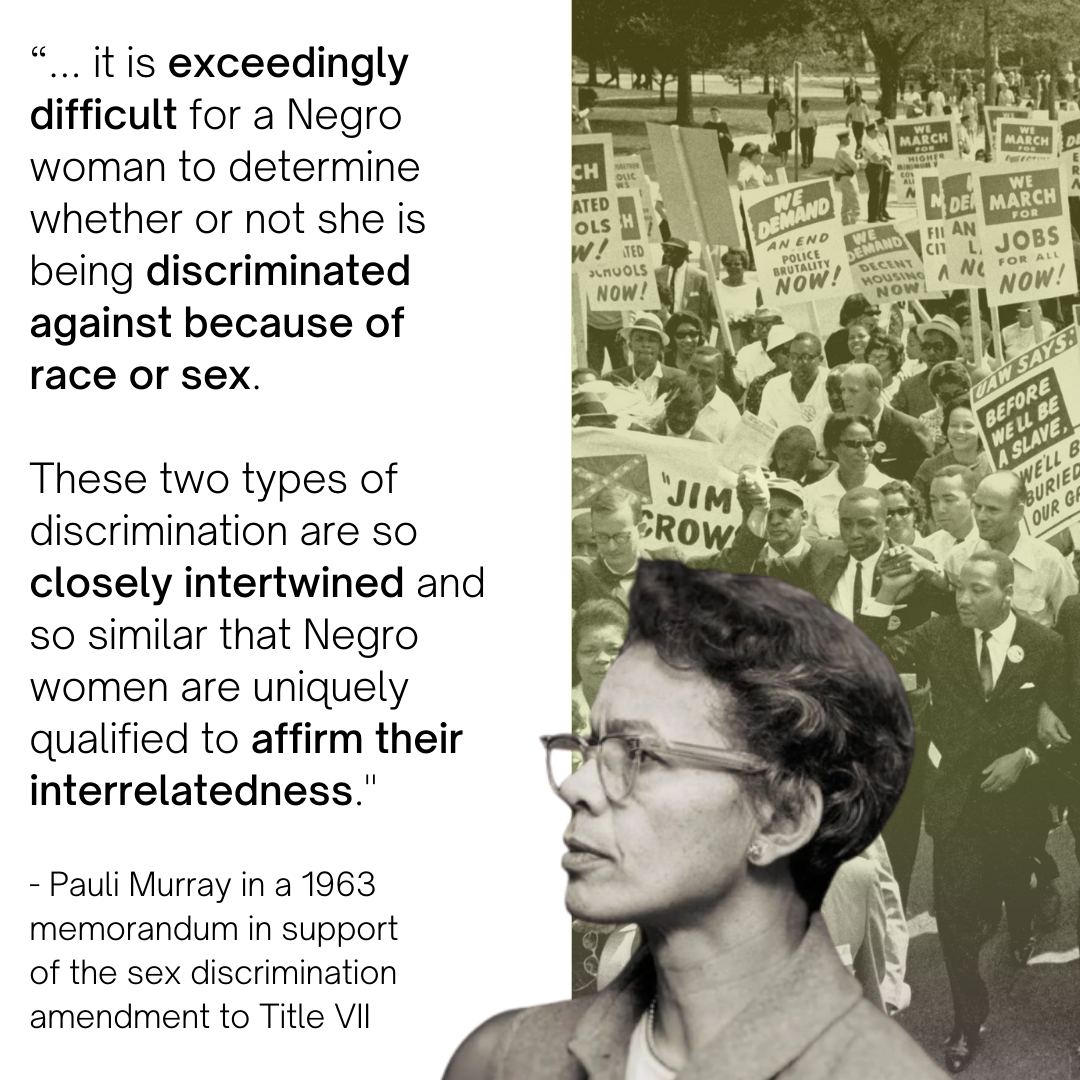The Schlesinger Library, Radcliffe Institute, Harvard University.
Pauli Murray’s Impact & Innovative Legal Spirit
Pauli Murray fundamentally shaped how we understand equality and American constitutional jurisprudence. Murray’s legal impact and scholarship defined and defended the rights of African Americans, women, and LGBTQ+ people.
Through their fight for gender equality, the elimination of Jim Crow, and the development of an intersectional legal approach, Dr. Murray was a true trailblazer.
Jim Crow & Odell Waller
“Jim Crow” refers to a collection of laws and norms that reinforced racial segregation and discrimination, especially in the Southern United States. After the legal emancipation of enslaved Black people, Southern states and towns created new rules to continue racial inequality and segregation. Black people were treated as inhuman and inferior, forbidden from accessing a broad range of rights and opportunities, such as voting. Jim Crow systems were enforced with a range of penalties: fines, arrests, imprisonment, and violence.
Article in Durham's Carolina Times, April 6, 1940. Titled “Jim-Crow Bus Dispute Leads to Girls’ Arrest.” Excerpt describes the arrest of Pauli Murray and companion Adelene McBean.”
While traveling in Virginia in 1940, Murray and their companion, Adelene McBean, refused to sit on broken seats at the back of the bus. The driver called the police and they were both arrested. Murray had already received national attention for challenging the University of North Carolina at Chapel Hill’s segregated graduate school programs. To avoid a legal challenge from the National Association for the Advancement of Colored People (NAACP), officials charged and fined Murray with “disorderly conduct” rather than for violating segregation laws.
In 1940, Murray was hired by the Workers’ Defense League in their campaign to pardon Odell Waller, a Black sharecropper convicted of murdering his white landlord. Murray traveled around the country to raise money for legal fees and advocate for Waller and other Black, Southern sharecroppers.
Waller’s case raised fundamental questions and concerns about economic and racial justice. He was convicted by a jury of white citizens who had paid the poll tax, a Jim Crow law that effectively barred Black and low-income people from taking part in trials and sentencing. Witnessing Waller’s case further motivated Murray into becoming a human rights lawyer. Odell Waller was executed on July 2, 1942, after the longest death row stay in the state’s history: 630 days.
Education & Segregation
Murray enrolled in Howard University School of Law in 1941 to become a civil rights lawyer. She was the only person perceived as a woman in her class and coined the term “Jane Crow'' to describe the intersectional oppression faced by Black women. As a law student, she helped form the Congress of Racial Equality, took part in several restaurant sit-ins, and continued to wield their typewriter.
During a civil rights seminar, Murray put forward a groundbreaking yet well-supported idea to overturn Plessy v. Ferguson (1896), a Supreme Court case that ruled segregation is constitutional. Murray argued Plessy v. Ferguson should be frontally attacked, explaining that segregation violated the Fourteenth Amendment’s Equal Protection Clause, as it implied “the right not to be set aside or marked with a badge of inferiority.” For their final thesis, Murray wrote a paper elaborating on this strategy. She made a ten-dollar bet with her professor, Spottswood Robinson: within 25 years, Plessy v. Ferguson was going to be overturned.
Not only did Murray win the bet, her strategy later ensured the 1954 Brown v. Board win. Her professor, Spottswood Robinson, provided her paper to Thurgood Marshall’s team and helped them develop their argument against segregation. Chief Justice Warren, when delivering the opinion of the court, echoed Pauli Murray’s argument in law school: according to modern psychological knowledge, segregation had a detrimental effect on children of color. Segregated educational facilities were declared inherently unequal under the Equal Protection Clause of the Fourteenth Amendment.
Gender Equality & LGBTQ+ Liberation
Pauli Murray was the only person perceived as a woman in her class at Howard University School of Law. While a student, Murray coined the term “Jane Crow'' to describe the intersecting discrimination against Black women. Murray expanded on this concept throughout their career, always focusing on the unique oppression of Black, working-class women.
Murray advocated for the inclusion of the word “sex” in the Civil Rights Act of 1964, which would make sex discrimination unconstitutional. After Title VII passed and gender became a “protected” category, Murray wrote an article about the continued challenges against Black, working-class women and the need for additional legal protections, particularly in regards to employment.
“We owe so much to her courage, to her willingness to speak out when society was not prepared to listen.”
Supreme Court Justice Ruth Bader Ginsburg credited Murray in the amicus brief she wrote for Reed v. Reed (1971), which was the first time the nation’s highest court recognized sex discrimination as unconstitutional due to the Fourteenth Amendment. Murray was cited as an honorary co-author of the brief.
On June 15, 2020, the Supreme Court ruled in favor of LGBTQ+ employees and ruled that workplace discrimination on the basis of sexual orientation and gender is unconstitutional. The opinion hinged on the word “sex” in the 1964 Civil Rights Act. By advocating for gender equality, Murray laid the foundation for further legal protection of LGBTQ+ communities.
Sources
Murray, Pauli, and Mary O. Eastwood. “Jane Crow and the Law: Sex Discrimination and Title VII.” George Washington Law Review, vol. 34, no. 2, 1965, pp. 232-56.
Oral History Interview with Pauli Murray, February 13, 1976. Interview G-0044. Southern Oral History Program Collection (#4007) in the Southern Oral History Program Collection, Southern Historical Collection, Wilson Library, University of North Carolina at Chapel Hill.
Sherman, Richard B. (1992). The Case of Odell Waller and Virginia Justice, 1940–1942. University of Tennessee Press.







![“Great art is not a matter of presenting one side or another, but presenting a picture so full of contradictions, tragedies, [and] insights of the period that the impact is at once disturbing and satisfying.”
—Pauli Murray, forewor](https://images.squarespace-cdn.com/content/v1/5c65c2920cf57db461b27ed8/1766773143666-XVO8MRREDCPUJ5LWPEJE/image-asset.jpeg)








